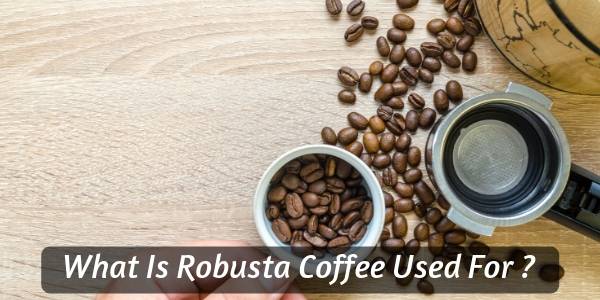Have you ever wondered what Robusta coffee is used for ? You keep hearing about it, but no one really talks about it in detail.
Why is it important, and why is it used, if people are so disappointed by its flavor ?
As it turns out, Robusta has quite a few uses, and was the savior of the coffee industry over a century ago.
Table of Contents
Robusta beans are strong, caffeine-heavy
Robusta beans are named Robusta for their strong, hardy nature.
This is mostly by comparison to Arabica beans.
You see, a long time ago, all the coffee grown all over the world was Arabica. Until the Coffee Leaf Rust found its way to Sri Lanka and neighboring parts of Asia.
It destroyed entire farms, so they had to resort to the next best thing: Robusta beans.
Not as tasty as Arabica, much harsher, and more caffeinated. This made them hardier, resistant to pests and diseases. Which means it was able to flourish in the places Arabica couldn't.
This led to the rise and establishment of Robusta coffee as a respected and useful bean.
By now you probably know that there's 2 main coffee bean types - Arabica and Robusta. And quite a few sub-classes of these two. Most are grown in the Coffee Belt, about 30 degrees North and South of the Equator.
But Robusta seems to be one of the most famous types, and somehow looked down upon.
Yes, Robusta can be terrible half the time in a hot brew, but it does have its good moments. Especially true if you cold brew it.
But it's a necessary coffee to have in the industry, and honestly it makes a big difference if you use Robusta or not, both in taste and in price. Let me explain.
1. Decaf is made with Robusta beans
If you're trying to cut down on caffeine, then you're probably drinking decaf to try and wean yourself.
Or, possibly some black tea since it's much lower in caffeine than coffee, but still gives you a kick in the morning.
There's a big difference between decaf and regular coffee, aside from the caffeine content.
And that big difference is that decaf uses Robusta beans. Which is funny, when you consider that Robusta has the highest caffeine content - 2.7%, compared to the 1.5% of Arabica.
Now, why use Robusta ? It's it kind of backwards to strip caffeine from the strongest coffee ?
Apparently not, since it's been the way decaf is made for decades.
The reason Robusta is used for decaf is that it's a very harsh tasting bean. And the decaf process strips lost of caffeine but also flavor. Arabica beans would lose almost all of their taste.
Another reason is the fact that Robusta beans are much, ,much cheaper than Arabica.
Partly because they yield a larger crop, and partly because people just love Arabica better.
So even if the decaf process is expensive, it's much cheaper to use tons of Robusta beans instead of more expensive and sensitive Arabica.
There you go. If you're drinking decaf, it's most probably Robusta. Look at the bag, see if it's true.
Recommended post: The Three Coffee Waves
2. Instant coffee uses Robusta as well
If you're an instant coffee lover, guess what ? You're also drinking Robusta.
Again, this is because of how cheap Robusta beans are.
The way instant coffee is made means quite a bit of coffee is lost. We don't really know of a better way to make instant cups.
Currently, the main process means a large amount of already brewed coffee is sprayed within a large, dry and warm tower. It's empty on the inside, and it very quickly dries the coffee drops.
These get reduced to their solid parts, which then drop to the bottom of the tower.
So, losing some Robusta won't hurt as much as losing some Arabica.
Plus the fact that instant coffee needs to retain some sort of flavor, which Arabica would lose in this process.
3. Robusta is found in many Arabica blends
This one you probably know.
Whenever you buy coffee, do you not check the labels on the bag ? If you do, you'll notice many of them boast "100% pure Arabica".
Which is part gimmick, and part quality assurance.
It's quality assurance because you know you're only getting Arabica, and for some this is an important point.
It's also part gimmick, since many pure Arabica blends, unless they're gourmet specialty blends, taste a bit watery, and incomplete.
Pure Arabica is a bit underwhelming, especially if you take your coffee with milk and sugar.
This is why a hint of Robusta will help. Many coffee blends contain some Robusta, though not all mention exactly how much.
What Robusta does in a blend is balance out the good flavor of Arabica with more caffeine, and a more pronounced coffee taste.
Much like adding a bit of salt and pepper, it contrasts Arabica very beautifully.
A pure Robusta would be almost too bad to drink on its own, in a hot brew. But a 30% Robusta, 70% Arabica blend would please a lot of people.
(If you like this article so far, you can pin it to your Pinterest board by clicking the image below. The article continues after the image.)
4. Robusta coffee helps espresso produce thicker crema
Ah, the crema in espresso. What every barista probably lives for.
I don't know, I;m not a barista. But I assume they would, otherwise they can't really make their lattes so pretty.
For some reason, Robusta beans produce a thicker crema on the espresso.
Now, this is a bit odd because the way the crema is made is that the hot water pushes some hot air bubbles through the fats and sugars of the bean. Which then render into the crema on top of the espresso.
Arabica has double the fat and sugar content of Robusta. So Robusta producing more crema is a bit odd at first, but it's something many baristas noticed.
However pure Robusta in espresso is not a good idea. But a blend of Robusta and Arabica ensures both taste and crema.
So there you have it, even your espresso probably as some Robusta in it.
Not all espresso blends have it, but many of them do. If you want to know for certain, ask you barista, or look closely at the coffee you're buying to see the Robusta/Arabica ratio.
5. Cold brewed Robusta for iced drinks turns out better
If summer's right around the corner - and it is, at the time of writing this - then you're probably breaking out the cold brew jars.
That's great because Robusta will help you out here.
I think this is one of the only ways to brew commercial Robusta and have it taste good. Hot brewing produces terrible results.
This is all because cold brewing extracts nutrients and flavor very differently than a hot brew. This means less acidity, and more sweetness.
The flavors in your Robusta, if you can believe there are any, will be much easier to observe in a cold brew.
You'll finally get to taste what people mean when they say Robusta has a peanut-y aftertaste, or some toffee notes.
They're much more evident when the coffee was extracted at a cold temperature.
It's also great because you can use less ground coffee than Arabica, to get a strong cold brew. Which will hold up very well to pretty much any flavoring you throw at it.
For an iced coffee, that's a big promise and you'll find Robusta won't disappoint.
Final thoughts
Whichever way you look at it, Robusta is a nice coffee to have around.
It manages to round up the flavor of pure Arabica, and it also have some separate uses that you maybe didn't think of before reading this.
Overall I think Robusta gets a worse rep than it deserves, and many people would be sorely disappointed in their morning cup of coffee if it were just pure Arabica.
By just the low caffeine content, if not by the watery flavor.
I went through several months of trying out pure Arabica. I think I had 6-8 different brands, and all were disappointing.
Ah well. I wouldn't've appreciated Robusta if I hadn't done that.
If you want to know more about coffee or tea, feel free to check the related articles below. Who knows what else you might find ?






